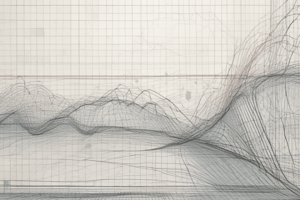Podcast
Questions and Answers
In a context diagram, what does the single process symbol in the center of the page represent?
In a context diagram, what does the single process symbol in the center of the page represent?
- An external entity interacting with each process.
- A specific sub-process within the information system.
- The primary data store for the system.
- The entire information system being modeled. (correct)
Why is it important to retain all connections that flow into and out of process 0 when expanding a context diagram into Diagram 0?
Why is it important to retain all connections that flow into and out of process 0 when expanding a context diagram into Diagram 0?
- To reduce the complexity of internal processes.
- To simplify the diagram and focus on essential functions.
- To allow for future expansion of the system's capabilities.
- To maintain consistency and ensure all external interactions are accounted for. (correct)
Which of the following is the primary purpose of Diagram 0 in system analysis?
Which of the following is the primary purpose of Diagram 0 in system analysis?
- To detail the system's user interface design.
- To provide an overview of all interacting components within the system. (correct)
- To illustrate the physical layout of the system's hardware.
- To define security protocols for the system.
What is the significance of system entities placed around the perimeter of a context diagram?
What is the significance of system entities placed around the perimeter of a context diagram?
What is a 'diverging data flow' in the context of data flow diagrams?
What is a 'diverging data flow' in the context of data flow diagrams?
What is the primary goal of 'leveling' in the context of Data Flow Diagrams (DFDs)?
What is the primary goal of 'leveling' in the context of Data Flow Diagrams (DFDs)?
Which of the following best describes the purpose of 'balancing' in the context of DFDs?
Which of the following best describes the purpose of 'balancing' in the context of DFDs?
In the context of DFDs, what is the significance of identifying 'functional primitives' during the leveling process?
In the context of DFDs, what is the significance of identifying 'functional primitives' during the leveling process?
Consider a scenario where a high-level DFD process, 'Process Order,' is decomposed into a lower-level DFD with processes like 'Validate Order,' 'Calculate Total,' and 'Schedule Delivery.' What principle ensures that the data flowing into and out of 'Process Order' is consistent with the combined data flows of its decomposed processes?
Consider a scenario where a high-level DFD process, 'Process Order,' is decomposed into a lower-level DFD with processes like 'Validate Order,' 'Calculate Total,' and 'Schedule Delivery.' What principle ensures that the data flowing into and out of 'Process Order' is consistent with the combined data flows of its decomposed processes?
When creating lower-level DFDs through leveling, how does the complexity of the diagrams typically change?
When creating lower-level DFDs through leveling, how does the complexity of the diagrams typically change?
Flashcards
Context Diagram
Context Diagram
A top-level view showing system boundaries and scope.
Process 0
Process 0
Represents the entire information system in a context diagram.
Diagram 0 DFD
Diagram 0 DFD
Shows all components interacting within the system.
Diagram 0 Elements
Diagram 0 Elements
Signup and view all the flashcards
Diverging Data Flow
Diverging Data Flow
Signup and view all the flashcards
Leveling in DFDs
Leveling in DFDs
Signup and view all the flashcards
Balancing in DFDs
Balancing in DFDs
Signup and view all the flashcards
Functional Primitive
Functional Primitive
Signup and view all the flashcards
DFD Balancing
DFD Balancing
Signup and view all the flashcards
Parent DFD
Parent DFD
Signup and view all the flashcards
Study Notes
Chapter 5: Data & Process Modeling
** EXAM CONTENT: **
- Errors: spontaneous generation, black hole, gray hole
- Processes, data flows, data stores, entities (section 5.3)
- Context diagrams, level-0, lower-level diagrams (sections 5.5, 5.6 & 5.7)
- Decision tables (5.9.4)
- Decision trees (5.9.5)
Logical vs Physical Models
- Logical Model: illustrates what a system must do, regardless of physical implementation
- Physical Model: presents how the system will be built
- Mainly follows a four-model approach, w/c develops:
- A physical model of the current system
- A logical model of the current system
- A logical model of the new system
- A physical model of the new system
Data Flow Diagrams (DFDs)
- Employ/Make use of symbols to depict how a system transforms input data into useful information
- A DFD displays the movement of data within an information system, excluding program logic or processing steps
- A set of DFDs provides a logical model, illustrating what a system does rather than how it does it.
Data Flow Diagram Symbols
- Data flow diagrams utilize four fundamental symbols that represent processes, data flows, data stores, and entities
- Several versions of DFD symbols exist
- DFD examples use Gane and Sarson symbols
- Yourdon symbols are another popular set
Process Symbols
- Processes contain business logic to transform data to the required results
- Process names identify a function by using a verb followed by a clear noun
- A process called "black box" has its inputs, output and functions known, but not the underlying logic
Data Flow Symbols
- A data flow is a path for data, allowing movement from one part of an information system to another
- A singular noun, and an adjective (if needed), should be used for the name
- A data flow in a DFD signifies data items
- Data flow is symbolized by a line, which could have a single or double arrowhead
Data Store
- A data store is used in a DFD to illustrate data that is stored by the system, which can be used later by processes
- In a DFD, the Gane and Sarson symbol for a data store is a flat rectangle open on the right and closed on the left
- A data store name uses a plural noun, adding adjectives where necessary, and must be associated with a process
Entity Symbols
- Rectagles may be shaded to look three-dimensional represent entities
- DFDs include solely the external entities providing data to the system or receiving output from it
- Entities in DFDs, also known as terminators, represent origins or final destinations of data
- An entity is called a source if supply to the system; whereas, it is a sink if it receives data
Drawing Data Flow Diagrams
- Guidelines to drawing a data flow diagram:
- Ensure the context diagram fits on one page.
- Use the information system's name as the process name in the context diagram.
- Employ names that are unique within each set of symbols.
- Avoid crossing lines.
- Provide a unique name and a reference number for each process.
- Ensure that the model is accurate, easy to understand, and addresses the needs of its intended users.
Context Diagram
- A context diagram offers a high-level view of the information system, outlining its scope and boundaries.
- Draw a context diagram, start with a single process symbol at the center representing the entire information system with the idenifier process 0
- Then place the entities around the perimeter of the page and link them to the central process using data flows.
Diagram
- It provides an overview of the components which interact to form the entire system
- It zooms in on the system, highlighting the major internal processes, data flows, and data stores, copying the entities and data flows from the context diagram
- The connections that flow into, and out of, process 0 must be retained
- A diverging data flow occurs if the same data travels to two or more locations
Lower-Level DFDs
- Leveling involves drawing increasingly detailed diagrams until functional primitives are apparent
- Balancing seeks to ensure consistency throughout DFDs by ensuring alignment of input and output data flows
Data Dictionary
- A data dictionary contains information about data, such as meaning, usage, origin, format and its connections to other data
- Data dictionaries typically include:
- Data element descriptions (also called a data item or field)
- Attribute/property definitions
- Relationship descriptions
- Rules and constraints
- Other metadata
- Each piece of data in the data dictionary requires documentation to provide comprehensive and clear information about data and processes within a system
- Data element attributes usually include what is documented in the data dictionary: name, alias, default value, type, source, security, and description
- The name or label of the data flow should have documentation in the data dictionary
- A data store should have documentation in the data dictionary
Process Description Tools in Modular Design
- A process description outlines the specifics of a functional primitive, denoting a certain sequence of processing steps and business logic
- Process descriptions in object-oriented development:
- O-O analysis synthesizes data and the processes acting on it into objects so similar objects can be grouped into classes
- O-O processes are called methods
- Modular design constructs a process from a combination of three logical structures: sequence, selection, and iteration
- Structured English uses a limited subset of standard English to clearly define a process with readability from using indentation
- A decision table shows the various conditions and outcomes systematically and creates actions based on numbered possibilities of credit approval
Studying That Suits You
Use AI to generate personalized quizzes and flashcards to suit your learning preferences.



